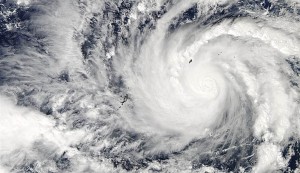It’s here.
Heavy rains and strong winds began to hit the eastern Philippines on Saturday ahead of a giant storm threatening more devastation to areas yet to recover from a super typhoon that killed thousands.
Typhoon Ruby (international name Hagupit) was moving slowly in the Pacific Ocean towards the Philippines and is expected to make landfall before dawn on Sunday, weather experts said. As of press time, ‘Ruby’ was said to still be moving around 200 kph.
More than 600,000 people in coastal areas were in evacuation centres according to the government, and many others were expected to pour in amid warnings of house-destroying winds, giant storm surges and landslides.
In other developments:
• Classes in all levels might be suspended once super typhoon Ruby hits the National Capital Region on Monday or Tuesday, according to Chairman Francis Tolentino of the Metro Manila Development Authority.
Local officials agreed with the national government to use a number of public schools in their areas as evacuation centers for residents who would be affected by storm surge, floods, and landslides caused by heavy rains and strong winds brought by Ruby.
• The Armed Forces of the Philippines said they it would provide the “muscle” in its disaster response operations, and will deploy ground troops in all critical areas that will be hit by typhoon Ruby’s fury.
AFP chief of Staff, Gen. Gregorio Catapang said he had directed all unified Commands in Luzon, Visayas and Mindanao for pre-positioning of troops, equipment, core of engineers, and medical doctors to cope up with possible damages to lives and properties.
“We will provide the muscle to assist people affected by typhoon Ruby through the delivery of needed items and to render humanitarian efforts to the badly affected areas,” Catapang said.
• In Tacloban City—the police have declared full alert status in the whole of Eastern visayas, prepositioning 1, 1 48 personnel for deployment and identified a total of 547 evacuation centers in the region.
‘Ruby’ was forecast to hit remote fishing communities on the far eastern island of Samar first, then cut across mostly poor farming central regions, and possibly the densely populated National |Capital Region.
Many communities in the central Philippines are still battling to recover from Super Typhoon Yolanda (Haiyan), the most powerful storm ever recorded on land, which left more than 7,350 people dead or missing in November last year.
In Tacloban, one of the cities worst-hit by Haiyan’s monster winds and tsunami-like storm surges, thousands of people on Saturday crammed into schools, churches and other evacuation centres.
In Catbalogan, the capital of neighbouring Samar island forecast to be the first place hit by the storm, authorities were preparing for water surges more than one storey high.
More than 10,000 people had been ordered into safe buildings, according to mayor Stephany Uy-Tan.
“We don’t want people to panic but I ordered forced evacuations so they would be safe,” the mayor said.
“There are always some people who say the wind is not yet that strong, that there is still no rain… we just have to explain that there is a huge possibility of a storm surge.”
In the eastern region of Bicol alone, authorities said they were aiming for 2.5 million people—half the local population—to be in evacuation centres by Saturday night.
On Saturday morning, Ruby was about 180 kilometres (110 miles) east of Samar island, according to local weather agency Pagasa.
Its rains and winds could impact 50 million people, or half the nation’s population, according to Social Welfare Secretary Corazon Soliman.
The typhoon was generating sustained winds of 185 kilometres an hour and gusts of 220 kilometres an hour which, if maintained at landfall, would make it the strongest to hit the Philippines this year.
The Philippines endures about 20 major storms a year which, along with regular earthquakes and volcano eruptions, make it one of the world’s most disaster-plagued countries.
The storms regularly claim many lives but they are becoming more violent and unpredictable because of climate change, according to the United Nations and many scientists.
Meanwhile, the Department of Environment and Natural Resources reported that 14 barangays in Metro Manila and houses built with light materials are highly susceptible to landslides and may be affected by strong winds while 820 barangays might be submerged by the expected heavy downpour. (Eagle News with details c/o MST Today)








